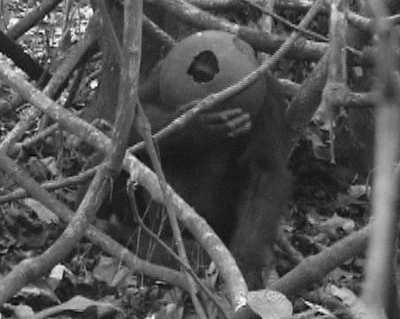|
<NOTE>
Playful Drumming by Immature Wild Chimpanzees at Mahale: Do They Enjoy Making Sounds?
Takahisa Matsusaka
Kansai University, Japan INTRODUCTION Before the Mahale Mountains National Park was established in 1985, several villages of Tongwe people lived in the forest. Although many years have passed since the people left, we can still sometimes find the remains of human artifacts on the forest floor while observing chimpanzees. Here, I report the rare cases where immature chimpanzees found and drummed on clay pots discarded by the former villagers and discuss their playful nature in relation to the origin of music. OBSERVATIONS
(1) Case of an 11-year-old adolescent male, Cadmus (CD) (25 Nov. 2002) At 10:15:29, an estrous adolescent female (QA) showed leaf-clipping courtship near CD, who did not respond. At 10:15:39, CD lifted the pot with both hands, put it on his head like a helmet, and tapped 31 times on its side with his right palm. Then he stamped on the ground four times and pounded the pot three times with his left fist. After stamping on the ground twice, he again tapped on the potís side with his right palm 14 times (Figure 1). 
Figure 1. CD puts a pot on his head and taps it with his palm. At 10:16:42, CD lowered his head, placed the pot on the ground, and kicked its rim twice with his right heel. Then he lowered one side of the rim with his right hand and kicked the rim with his right heel ten times. At 10:17:19, CD stood up, kicked backward, and pushed the pot with his right sole. The pot rolled off, and he left. In total, CD drummed 60 times: 45 times with his right palm, three times with his left fist, and 12 times with his right heel. He calmly drummed with no pilo-erection. His face was not visible when he put the pot on his head, but he drummed on it on the ground with no facial expression. He generally tapped lightly and did not make loud sounds. Although he might have heard the potís large resonance from inside it, the sounds did not seem to attract others. No one approached CD during his drumming, even though six chimpanzees rested within 10 m: OS and his mother, a 1-year-old male infant (TD) and his mother, an adult male (DG), and an adolescent female (QA). (2) Case of a 6-year-old juvenile male, Michio (MC) (14 Feb. 2003) At 10:46:56, while MC was walking in a thicket, he found a large clay water pot that was about 50-cm high, with a 45-cm diameter, a narrow neck, and an 18-cm diameter mouth. He slapped the bottom of it three times with his left palm, rolled it, and slapped it once with his right palm. Then he stepped onto it with both feet, soon got off it, lowered the potís mouth to the ground, and slapped its bottom with his left palm. He then pushed and rolled it, slapped it simultaneously with both palms, and slapped it nine times with both hands in turns. At 10:47:19, he stopped but soon started playing again in various ways (Figure 2, Video 1: available online at mahale.main.jp/PAN/19_2/19(2)_05.html): slapping the pot with his palms, pushing and rolling it, stamping on it with his soles, kicking it with his heels, stepping up onto it, dropping his buttock on it, and lying supine on it. He also showed such exploratory behaviors as touching its crack, looking into it, putting his arm into it, etc. 
Figure 2. MC slaps a pot with his palms. Video 1 At 10:52:11, MC strongly kicked the pot five times with his right heel, chipping off a small piece. He touched the spot with his right hand and slapped it eight times with both palms in turns. Then he stepped up onto the pot and stamped on it six times with his sole, and the pot finally broke into pieces, and he fell off of it (10:52:57). One-year-old male infant, TD, approached within 5 m of MC and observed the scene. MC lifted one of the broken pieces, but soon went away and approached TD and his mother. After a while, TD came, touched the broken pieces, and stepped on them, but no one paid any attention to the pieces after that. In total, MC drummed on the pot 199 times: 36 times with his right hand, 112 times with his left hand, four times simultaneously with both hands, 25 times with his right leg, eight times with his left leg, four times with his buttock, and ten times with unidentified body parts. He used his left hand more than his right hand and his right leg more than his left leg. When he drummed with his hands, he usually used his palms (149 times) but he also used his fist (twice) and his wrist (once). When he drummed with his legs, he used his sole (23 times) and his heel (10 times). MC usually drummed on the side or the bottom of the pot, but he also hit its rim (once) and neck (twice). Since the pot has a round bottom, it was unstable and easy to roll. MC seemed to try to control the potís orientation and position by pushing or dragging it, lowering or lifting its mouth, and supporting it with his limbs. Supporting behaviors were observed nine times: three times with his right hand, once each with both hands, the right leg, the left leg, both legs, and combinations of right hand/left leg and right hand/right leg. His right hand was used six times, and his left hand was used only once. MC drummed the pot with no pilo-erection and with a half-open mouth, which is his relaxed face. He drummed relatively strongly, and the sounds were probably audible to others nearby. However, most chimpanzees did not show much interest in his drumming; six others rested within 10 m: MCís mother and her 1-year-old female infant, TD and his mother, and two adult males (AL, PM). Only TD came to the spot after the pot was finally smashed. DISCUSSION CD put the pot on his head like a helmet and tapped it with his palms and kicked it on the ground. He drummed 60 times in about two minutes. MC showed more varied behavioral patterns, including slapping, kicking, stepping up, and rolling. He drummed 199 times in about six minutes. These can be regarded as “object play” in which they experienced various types of object manipulation, and also as “sound play” in which they enjoyed making sounds. During drumming, they sometimes changed the potís orientation and position and drummed on various spots with different body parts. They seemed to enjoy modifying the sounds and hearing the unexpectedly large and resonant sounds from the pot. Immature chimpanzees sometimes make sounds during play. They might slap a tree buttress or walk on branches in an exaggerated style to make pitapat sounds. They also make sounds when they play with dry leaves1. Some immature chimpanzees (including CD and MC) occasionally slap their own bellies with their palms to make spanking sounds as solo play or play solicitation2,3. They may also enjoy making sounds in these cases, but these cases generally last only for a few seconds. The cases observed in this study were exceptionally long. The relatively large and resonant sounds of the pot should have encouraged them to continue drumming. Adult male chimpanzees often hit or kick a substratum to make banging sounds as an intimidation display, such as slapping the ground or slapping/kicking tree buttresses or metal walls4,5. The clay pot drumming observed in this study featured several differences from such adult drumming. CD and MC were not very excited, unlike adult displays; they did not show pilo-erection or such tense facial expressions as compressed lips. They seemed relaxed and drummed for a much longer duration. They did not pay much attention to other chimpanzees and appeared absorbed in their solo activity. Others did not show much interest in their drumming, either. An individual difference was found in the laterality. CD usually drummed with his right hand and leg, while MC used his left hand and right leg more often. When supporting the pot, MC mostly used his right hand. Thus, MC showed a tendency of role differentiation in using his hands for drumming and supporting. Individual differences of drumming patterns and laterality were also reported for intimidation drumming by adult males4,5. In summary, two immature chimpanzees engaged in long and variable solo play, suggesting that they enjoyed producing sounds. In discussion on the origin and evolution of music, much attention has focused on such social aspects as vocal communication and sexual selection6. However, the individual capacity to enjoy manipulating sounds also seems essential for the origin of music. This study suggests that chimpanzees have the potential to enjoy making sounds and supports the notion that manual drumming in African great apes is homologous to human instrumental music7. ACKNOWLEDGEMENTS I thank the Tanzania Commission for Science and Technology, the Tanzania Wildlife Research Institute, and the Tanzania National Parks for permission to work at Mahale, the Mahale Mountains Wildlife Research Centre and Mahale Mountains National Park for logistic support, and Dr. H. Hayaki and Dr. M. Nakamura for their valuable comments on this manuscript. This study was financially supported by MEXT Grant in-Aid for Scientific Research (#12375003 and #16255007 to T. Nishida) REFERENCES
Back to Contents |